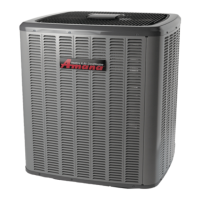Do you have a question about the Goodman ComfortNet ASXC160361BC and is the answer not in the manual?
Critical warnings regarding operating conditions, materials, and training.
Critical warnings related to refrigerant properties and safe handling practices.
Explains the coding system for ASXC/GSXC condensing units, including brand, type, and capacity.
Details the coding system for indoor coils, covering unit application, refrigerant, and capacity.
Explains the coding for MBVC modular blowers, including brand, type, and airflow specifications.
Details the coding system for AVPTC air handlers, including unit application, capacity, and electrical specs.
Explains the coding for single-piece air handlers, covering brand, application, and capacity.
Explains the design characteristics of scroll compressors, including two-stage modulation.
Explains the two-stage capacity control mechanism in ComfortNet™ models.
Details the features and installation considerations for AVPTC air handlers.
Explains the UC PCB's role in communicating HVAC systems and its features.
Explains the R-410A refrigerant and basic refrigeration cycle principles.
Details the operation of the cooling cycle for communicating thermostats.
Details the operation of the heating cycle for heat pumps with communicating thermostats.
Explains how the UC PCB and OCT sensor control the defrost cycle.
Illustrates the refrigerant flow during the cooling cycle.
Illustrates the refrigerant flow during the heating cycle.
A chart to diagnose cooling and heat pump system issues based on symptoms and possible causes.
Covers checking voltage, wiring, transformer, and control circuits.
Details checks for thermostats, unitary controls, and relays.
Covers capacitors, motors, compressors, and heaters.
Covers leak testing, evacuation, charging, and superheat/subcooling.
Step-by-step procedure for checking system voltage and locked rotor voltage.
Guidelines for visually inspecting and testing wiring for damage or loose connections.
Explains the ComfortNet system and its communication differences from legacy systems.
Discusses airflow management in communicating vs. legacy systems and airflow demand sources.
Covers control wiring recommendations and the standard CTK04 wiring setup.
Explains accessing system information, setup, and diagnostic features.
Addresses troubleshooting the ComfortNet™ system network using LEDs and learn button.
Provides a chart for diagnosing communication issues based on LED status and possible causes.
Lists conditions indicated by the 7-segment LED display on the control module.
Details diagnostic codes, possible causes, and corrective actions for specific air handler control boards.
Lists additional diagnostic codes, possible causes, and corrective actions for PCBJA101-PCBJA102.
Details diagnostic codes related to motor issues and their resolutions.
Covers diagnostic codes for motor faults and airflow issues with corrective actions.
Details diagnostic codes for power supply and network data issues for PCBJA104.
Details diagnostic codes related to motor operation issues and their corrective actions.
Covers diagnostic codes for motor faults, voltage issues, and airflow problems.
Explains diagnostic codes for PCBJA104, including heater kit mismatch and auxiliary switch issues.
Procedures for checking ECM motors, including voltage and relay contacts.
Explains how to use Copeland Comfort Alert™ diagnostics for specific models.
Lists diagnostic codes for ComfortNet™ systems, including symptoms, faults, and causes.
Details diagnostic codes for low/high side faults, HPCO Lockout, and short cycling.
Covers diagnostic codes for locked rotor, open circuit, and open start circuit faults.
Details diagnostic codes for open run circuit, low/high line voltage, and low pilot voltage.
Lists diagnostic codes for compressor protector open, no line voltage, and low pilot voltage.
Details the critical process of evacuating the system to remove air and moisture.
Provides instructions for charging the system with the correct refrigerant amount.
| Model | ASXC160361BC |
|---|---|
| Type | Heat Pump |
| Cooling Capacity (BTU/h) | 36000 |
| SEER Rating | 16 |
| HSPF Rating | Up to 9.5 |
| Refrigerant | R-410A |
| Compressor Type | Scroll |
| Voltage | 208/230 |
| Heating Capacity (BTU/h) | 36000 |
| Phase | 1 |
| Stages | 2 |
| Sound Level (dB) | 72 |












